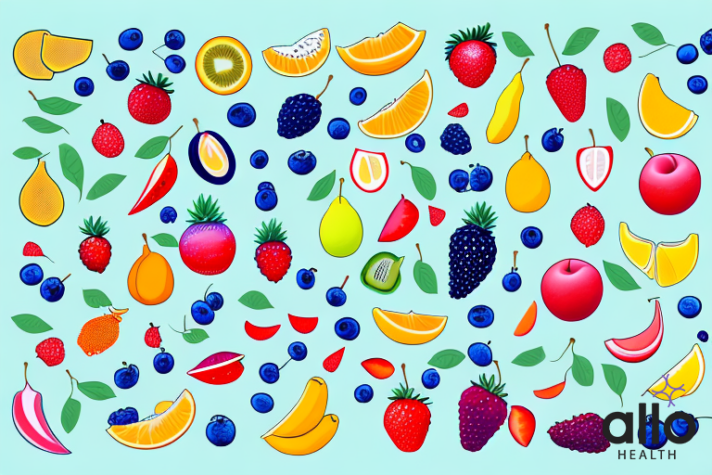A List of Fruits That Can Help Reduce Creatinine Levels

Allo Health is dedicated to personalized well-being, offering support and trusted information tailored to individual health goals. The platform emphasizes human-generated content, led by a distinguished medical team of experts, including physicians and sexual health specialists. Their commitment to credibility involves rigorous fact-checking, authoritative research, and continuous updates to ensure accurate, up-to-date information. Allo Health's unique approach goes beyond conventional platforms, providing expert-led insights and a continuous commitment to excellence, with user feedback playing a crucial role in shaping the platform's authoritative voice.

Dr.Sushma.V completed MBBS degree from BGS GIMS,bangalore
Why This Was Upated?
Our experts continually monitor the health and wellness space, and we update our articles when new information became available.
Updated on 15 January, 2024
- Article was updated as part of our commitment to diversity, equity, and inclusion.

"The following blog article provides general information and insights on various topics. However, it is important to note that the information presented is not intended as professional advice in any specific field or area. The content of this blog is for general educational and informational purposes only.
Book consultation
The content should not be interpreted as endorsement, recommendation, or guarantee of any product, service, or information mentioned. Readers are solely responsible for the decisions and actions they take based on the information provided in this blog. It is essential to exercise individual judgment, critical thinking, and personal responsibility when applying or implementing any information or suggestions discussed in the blog."
Are you struggling with high creatinine levels? Do you want to control these levels and improve your overall health? If so, incorporating certain fruits and vegetables into your diet plan may be the solution you’ve been looking for. In this article, we explore the benefits of consuming fruits to lower creatinine levels and provide a list of the top 7 fruits to include in your diet. Explore the different list of fruits to reduce creatinine level. Learn more about how these fruits can help you achieve a healthier lifestyle.
What is Creatinine and Why is it Important to Control its Levels?
Creatinine is a waste product that is produced by the muscles in your body during the normal metabolic process. It is filtered out of the blood by the kidneys and eliminated from the body through urine. High levels of creatinine in the blood can indicate kidney damage or dysfunction, which can lead to serious health complications. That’s why it is essential to control the levels of creatinine in your body.
There are several factors that can contribute to high levels of creatinine in the blood, including dehydration, certain medications, and underlying medical conditions such as diabetes and high blood pressure. It is important to identify and address these underlying causes in order to effectively control creatinine levels.
There are several lifestyle changes that can help to control creatinine levels, such as staying hydrated, maintaining a healthy diet, and engaging in regular exercise. In some cases, medication or medical procedures may be necessary to manage creatinine levels and prevent further kidney damage.
Understanding The Impact of High Creatinine Levels on Your Health
When the levels of creatinine become too high, it can lead to conditions such as chronic kidney disease, glomerulonephritis, and pyelonephritis. In addition to these conditions, high creatinine levels can also cause symptoms such as dehydration, vomiting, and fatigue. Lowering your creatinine levels through dietary and lifestyle changes can help you avoid these complications and improve your overall health.
It is important to note that high creatinine levels can also be a result of certain medications, such as nonsteroidal anti-inflammatory drugs (NSAIDs) and some antibiotics. If you are taking any of these medications and notice an increase in your creatinine levels, it is important to speak with your healthcare provider about alternative options or adjusting your dosage.
Can Fruits Really Help Reduce Creatinine Levels?
Yes, fruits are a great addition to your diet when looking to reduce creatinine levels. Certain fruits contain compounds that help detoxify your body and improve renal function. These compounds help to reduce the workload of your kidneys and help your body eliminate waste faster. On top of that, fruits are also a natural source of antioxidants, which help to protect your body from cellular damage caused by free radicals.
Some of the best fruits to include in your diet when looking to reduce creatinine levels include berries, such as blueberries, strawberries, and raspberries, as well as citrus fruits like oranges and lemons. These fruits are high in vitamin C, which is known to help improve kidney function and reduce inflammation in the body.
It’s important to note that while fruits can be beneficial for reducing creatinine levels, they should be consumed in moderation. Fruits are also high in natural sugars, which can cause a spike in blood sugar levels if consumed in excess. It’s best to speak with a healthcare professional or registered dietitian to determine the appropriate amount of fruits to include in your diet based on your individual needs and health status.
Top 7 Fruits To Include In Your Diet To Lower Creatinine Levels
A list of fruits to reduce creatinine levels are-
- Kidney beans
- Cranberries
- Mangoes
- Papayas
- Watermelons
- Grapes
- Pineapples
1. Blueberries: Blueberries are rich in antioxidants and have anti-inflammatory properties that can help reduce creatinine levels. They are also low in potassium, making them a great option for people with kidney disease.
2. Apples: Apples are a great source of fiber and vitamin C, and they also contain antioxidants that can help protect the kidneys. Eating apples regularly can help lower creatinine levels and improve overall kidney function.
How Do These Fruits Help Lower Creatinine Levels?
Kidney beans contain arginine, an amino acid known for its detoxifying properties. Cranberries are high in proanthocyanidins, compounds that prevent bacteria from sticking to the walls of your bladder and urinary tract. This action helps to reduce inflammation and increase urinary flow, promoting the elimination of waste products. Mangoes and papayas are rich in fiber, which helps to regulate your digestive system and reduce the workload of your kidneys. Watermelons contain lycopene, which is a powerful antioxidant that neutralizes free radicals and promotes healthy cell function. Grapes are high in resveratrol, a compound that has anti-inflammatory properties and helps to protect your kidneys from damage. Pineapples contain bromelain, an enzyme that helps to break down proteins and reduce inflammation.
In addition to the fruits mentioned above, there are other foods that can help lower creatinine levels. For example, leafy greens like spinach and kale are rich in vitamins and minerals that support kidney function. They also contain antioxidants that help to reduce inflammation and protect against cellular damage. Additionally, foods high in omega-3 fatty acids, such as salmon and other fatty fish, can help to reduce inflammation and improve kidney health.
It’s important to note that while these foods can be beneficial for kidney health, they should not be used as a substitute for medical treatment. If you have high creatinine levels, it’s important to work with your healthcare provider to develop a comprehensive treatment plan that addresses the underlying cause of your condition.
Incorporating These Fruits Into Your Diet Plan
The easiest way to incorporate these fruits into your diet plan is to include them in your daily meals. You can add kidney beans to salads, soups, and stews. Cranberries and grapes can be eaten as snacks or added to smoothies. Watermelons, mangoes, papayas, and pineapples are great for fruit salads, smoothies, or as a standalone snack. Aim to include a variety of these fruits in your diet to benefit from their diverse nutritional content.
Another way to incorporate these fruits into your diet plan is to use them as substitutes for less healthy options. For example, instead of reaching for a sugary dessert, try having a bowl of mixed berries or a slice of watermelon. You can also use mashed avocado as a spread instead of mayonnaise or butter. By making these small substitutions, you can improve the overall nutritional value of your meals and snacks.
Other Dietary Changes You Can Make To Aid Reduction of Creatinine Levels
Follow a balanced diet to reduce creatinine levels. In addition to incorporating fruits into your diet plan, other dietary changes can help to reduce your creatinine levels. Avoid processed foods, sugary beverages, and foods high in sodium. These foods can increase the workload of your kidneys and cause water retention. Instead, opt for whole foods, lean protein, and healthy fats like olive oil and avocado. You should also aim to drink plenty of water to help flush out toxins and enhance your kidney function. Limit too much fluid intake and restrict salt intake.
Another dietary change that can aid in reducing creatinine levels is to limit your intake of animal protein. Animal protein, such as meat, poultry, and fish, can increase the production of creatinine in your body. Consider replacing some of your animal protein with plant-based protein sources, such as beans, lentils, and tofu. Additionally, reducing your alcohol intake can also help to lower your creatinine levels, as alcohol can cause dehydration and put additional strain on your kidneys.
The Role of Exercise in Managing High Creatinine Levels
Regular exercise can help to improve your overall health and enhance kidney function. Aim to get at least 150 minutes of moderate exercise per week. This can include activities such as walking, cycling, or swimming. Exercise helps to regulate your blood pressure, reduce inflammation, and enhance circulation, which are all factors that improve renal function and reduce creatinine levels.
In addition to regular exercise, it is important to maintain a healthy diet to manage high creatinine levels. A diet that is low in protein and sodium can help to reduce the workload on your kidneys and prevent further damage. It is also important to stay hydrated by drinking plenty of water throughout the day.
While exercise can be beneficial for managing high creatinine levels, it is important to consult with your healthcare provider before starting any new exercise program. They can help you determine the best type and intensity of exercise for your individual needs and medical history.
Tips for Monitoring Your Progress After Adopting These Changes
After incorporating these dietary and lifestyle changes, it’s important to monitor your progress to determine the effectiveness of your efforts. You can do this by tracking your creatinine levels through blood tests, monitoring your urine output and color, and observing any improvements in your overall health. Keep in mind that it can take several weeks to see the effects of these changes, so be patient.
In addition to these methods, it may also be helpful to keep a food and activity journal to track your daily habits. This can help you identify any areas where you may need to make further changes or adjustments. Additionally, consider setting specific goals for yourself, such as increasing your daily water intake or incorporating more physical activity into your routine. By setting goals and tracking your progress, you can stay motivated and continue to make positive changes for your health.
When to Seek Medical Intervention for High Creatinine Levels
If your creatinine levels remain elevated despite making these dietary and lifestyle changes, it may be time to seek medical intervention. Your doctor may recommend medications to help improve your kidney function or suggest additional therapies to address underlying health conditions.
It is important to note that high creatinine levels can be a sign of kidney damage or disease. If you experience symptoms such as frequent urination, fatigue, swelling in the legs or feet, or difficulty breathing, it is important to seek medical attention immediately. Your doctor may recommend further testing, such as a kidney function test or a urine analysis, to determine the underlying cause of your high creatinine levels and develop an appropriate treatment plan.
Conclusion: A Holistic Approach To Managing High Creatinine Levels
Reducing your creatinine levels is not just about consuming the right foods, but also adopting a holistic approach to improving your overall health. Incorporating the above-mentioned fruits into your diet plan, making dietary changes, exercising regularly, and monitoring your progress are all essential steps to take. By doing so, you can improve your kidney function, reduce your creatinine levels, and enhance your overall health and wellbeing.
In addition to the above-mentioned steps, it is also important to manage your stress levels. High levels of stress can lead to an increase in creatinine levels. Practicing relaxation techniques such as meditation, yoga, or deep breathing exercises can help reduce stress levels and improve overall health.
Furthermore, it is important to stay hydrated by drinking plenty of water. Dehydration can lead to an increase in creatinine levels. Aim to drink at least 8-10 glasses of water per day to keep your body hydrated and help flush out toxins from your kidneys.
Frequently Asked Questions-
Q1. Which Fruit Is Best for Lowering Creatinine?
Fruits like kiwi, blueberries, apples and cranberries are rich in antioxidants and help lower creatinine levels. Strawberries are rich in polyphenols, antioxidants and vitamin C that promotes healthy skin and removes excess creatinine effectively from the body. Cranberries are superfoods rich in antioxidants and minerals and maintain the creatinine levels in the body. It contains Heroesilven, an antioxidant that helps in the removal of excess creatinine. Apples are good sources of fiber, potassium and flavonoids that lower creatinine levels and antioxidants that aid in the treatment of kidney diseases. Blueberries help to manage creatinine levels in the body. They also help to lower blood pressure, manage diabetes, and maintain the health of the kidney. Raspberries are external sources of potassium, manganese, iron and vitamin C, K and E that promote healthy functioning of the kidneys. Vitamins C, K, E, and folate are abundantly present in raspberries. Cherries remove excess creatinine from the body.
Q2. Which Food Reduces Creatinine Levels?
Fruits – Some examples of antioxidant-rich fruits are blueberries, strawberries and raspberries. They have anti-inflammatory properties that help protect kidney function and reduce oxidative stress. Citrus fruits such as lemons and oranges also lower creatinine levels. Watermelon is a natural diuretic that flushes out toxins because it has high water content.
Vegetables – Green leafy vegetables such as spinach and kale are good sources of antioxidants that lower creatinine. Red bell peppers are low in potassium but high in vitamins A, C, and B6 which may support kidney health. Cucumbers act as natural diuretics as they have high water content.
Fiber Foods – Fiber foods help to lower creatinine levels in the body. Fiber foods include whole grains, legumes and vegetables. A low-protein diet also reduces creatinine levels.
Ginger – Ginger has anti-inflammatory properties that reduce the inflammation of the kidneys.
Water – Adequate amount of water helps dilute the blood’s creatinine concentration and promotes its excretion in the urine.
Q3. What Fruits to Avoid for Creatinine?
Bananas and kiwi have high potassium levels may put extra strain on the kidneys, potentially worsening kidney function. Oranges are rich sources of vitamin C and other antioxidants. However, high levels of vitamin C can lead to the formation of kidney stones.
Q4. How to Lower Creatinine Levels?
Adequate Hydration- Adequate hydration is one of simplest way to reduce creatinine levels in the body. Drinking plenty of water flushes out toxins and waste products from the body, including creatinine. One should aim to drink at least 8-10 glasses of water per day.
Low-Protein Diet- Reducing protein intake can help lower creatinine production. Meat, poultry, fish, and dairy products are good sources of protein that should be limited.
Control Blood Sugar Levels: Uncontrolled diabetes is an important factor for elevated creatinine levels. Maintaining blood glucose levels help prevent high creatinine levels.
Avoid Certain Medications: Some medications, such as Nonsteroidal anti-inflammatory drugs (NSAIDs) like Ibuprofen and Naproxen, can damage kidney function.
Exercise Regularly: Doing regular physical activity improves overall kidney function and lower creatinine levels.
Q5. What Are Fiber Foods to Lower Creatinine?
Oats contain a soluble fiber called beta-glucan that reduces cholesterol and blood glucose levels. Oats support kidney function and reduce creatinine levels in the body. Legumes such as chickpeas, lentils and kidney beans are rich in soluble and insoluble fiber. Fruits and vegetables rich in fiber are apples, pears, berries, broccoli, carrots, and Brussels sprouts. They also contain antioxidants, vitamins and minerals.
Q6. Does Drinking Water Reduce Creatinine Levels?
Creatinine is a waste product of muscle metabolism. Water helps to flush out toxins and wastes, including creatinine. Hence it is essential to take more water to eliminate toxins from your body.
Q8. How to Reduce Creatinine Levels by Yoga?
Yoga is a holistic practice that promotes mental, physical and spiritual well-being. Regular practice of yoga has been shown to have numerous health benefits, including enhanced organ function. Yoga can help reduce creatinine levels in the body and supports kidney function. Certain yoga asanas are believed to stimulate the kidneys and improve their functioning. Certain yoga poses like Ardha Matsyendrasana (Half Spinal Twist), Bhujangasana (Cobra Pose), Dhanurasana (Bow Pose), and Pavanamuktasana (Wind-Relieving Pose) are thought to enhance blood circulation to the kidneys and help eliminate toxins from the body.
Q9. What Foods to Avoid for Creatinine?
High-Protein Foods:
Excessive proteins can increase creatinine levels as it leads to increased production of creatinine.
Sodium-Rich Foods:
High sodium content leads to fluid retention, which can strain the kidneys, especially in kidney patients. To reduce sodium intake, avoid processed foods such as canned foods, fast foods, salty snacks, soy sauce and ketchup.
Foods High in Potassium and Phosphorus:
Foods to limit or avoid include bananas, oranges, tomatoes, potatoes, avocados, dairy products, nuts, and seeds are high in potassium content. Also, it is important to avoid processed foods containing phosphorus additives.






































